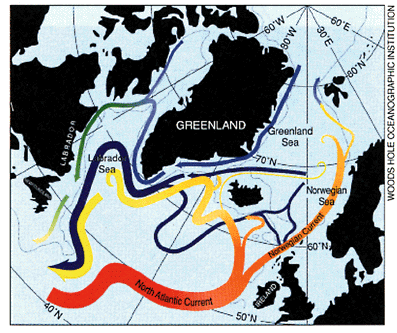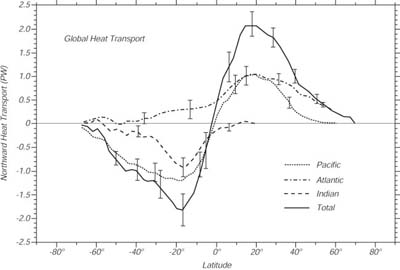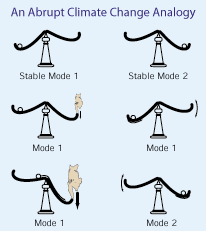
Abrupt Climate Change
Analysis of many different types of data collected throughout the world has shown that climate can change abruptly. The record is roughly 6°C in 1–3 years recorded in Greenland ice cores (Steffensen et al 2008) and in a core through sediments in a German lake (Brauer et al 2008). Ice cores from Antarctica and Greenland show:
- Rapid climate changes, between multiple nearly stable states, can
and do occur. Look at the plot of temperature on
the Carbon Dioxide Problem web page.
Notice the different periods of relative constant temperature:
- 0 to 12,000 years ago at a temperature in Greenland of 0°C.
- 15,000 to 30,000 years ago at a temperature in Greenland of –8°C.
- 90,000 and 120,000 years ago at a temperature in Greenland of –4°C.
- 200,000 to 210,000 years
ago at a temperature in Greenland of –2°C.
Thus we see five periods of nearly stable climate lasting tens of thousands of years. Many others are seen in the plot, lasting hundreds to thousands of years.
These are examples of multiple nearly stable climate states separated by times of rapid (abrupt) change.
An Example
Here is an example from the period called The Younger Dryas seen clearly in European Greenland data. This period is named after a flower (Dryas octopetala) that grows in cold conditions and that became common in Europe during this time.
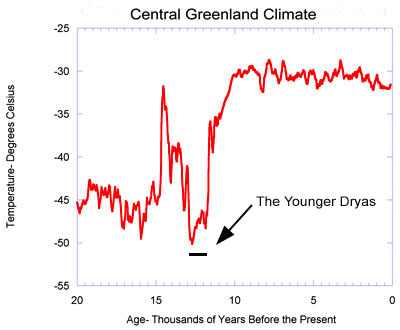
Central Greenland temperature over the past 20,000 years from analysis of oxygen isotope ratios in Greenland ice cores.
From NOAA The Younger Dryas cold interval as viewed from central Greenland.
_F3.jpg)
Transitions in deuterium isotope concentration (d) observed in Greenland ice cores sampled with a resolution of 1–3 years. The deuterium isotopes are closely related to temperature of the oceanic area that supplied moisture that led to Greenland precipitation. The data show that the atmosphere switched mode within 1 to 3 years (horizontal grey bands) during these transitions and initiated a more gradual change (over 50 years) of the Greenland air temperature, as recorded by stable water isotopes.
From Steffensen et al 2008).
- Abrupt changes in the deep mass circulation (indicated in part by
comparison of Antarctic and Greenland ice core records) have taken
place, associated with large and rapid changes in climate.
- There are strong linkages between the physical and biogeochemical aspects of the earth system. They show up in variations of key atmospheric trace constituents such as CO2, CH4, N2O and aerosols (small particles in the air, not the gas in an aerosol can).
- The earth system is characterized by both positive (self-reinforcing)
feedbacks which lead to rapid changes and negative (self-limiting)
feedbacks which lead to more-or-less stable periods of CO2 concentration
in the ice cores.
From Newsletter of the Global, Analysis, Integration, and Modeling (GAIM) Taskforce of the International Geosphere Biosphere Program, Summer 2003, page 13-14.
The possibility of abrupt climate change due to changes in the deep circulation of the north Atlantic was first proposed by Wallace Broecker of the Lamont-Doherty Observatory of Columbia University. He is the one who wrote:
"... it is clear that Earth's climate system has proven itself to be an angry beast. When nudged, it is capable of a violent response." From: Broecker (2003).
Wallace Broecker of Lamont-Doherty Earth Observatory.
The Ocean and Abrupt Climate Change
The ocean and atmosphere transport heat from the tropics to high latitudes. The ocean transport is important at the lower latitudes, and the atmosphere is important at higher latitudes. See the zonal average of heat transport from the Ocean and Climate web page. The meridional overturning circulation in the Atlantic plays an important role in the oceanic heat transport system and abrupt climate change.
The Meridional Overturning Circulation in the Atlantic
In winter,
the surface waters of the North Atlantic Ocean cool and become so cold
and dense that they sink to the bottom. The sinking water carries CO2 deep
into the ocean, removing it from contact with the atmosphere. The sinking
water must be replaced by northward transport of water at the
surface. Because the Atlantic is connected to the rest of the ocean through
the Antarctic Circumpolar Current, the replacement water must come all
the way from the far South Atlantic.
The surface (red) and deep (blue) circulation in the North Atlantic. The sinking of water in the Norwegian and Greenland Seas helps keep the far North Atlantic ice free, leading to a warmer Europe. From: Woods Hole Oceanographic Institution.
As the water moves northward along the surface, it passes the tropics where it is warmed to nearly 28° C. Thus, heat transport in the Atlantic is everywhere to the north, even in the southern hemisphere. All the solar heat absorbed by the Atlantic, about one petawatt, is carried northward to warm the northern hemisphere. The heat is lost when the warm water cools keeps the far North Atlantic ice free, and it helps keep Europe warm.
Northward heat transport for 1988 in each ocean and the total transport summed over all oceans.
From Houghton et al., (1996: 212), which used data from Trenberth and Solomon (1994).
Abrupt Changes in the Meridional Overturning Circulation
Ice and ocean sediment core data show many instances of the northern-hemisphere
climate changing abruptly. The change seems to be related to changes
in the meridional overturning circulation. Here is what
happened:
- Large numbers of icebergs were dumped into the North Atlantic by continental glaciers. The icebergs carried sand and gravel which fell to the bottom as the ice melted. The layers of sand and gravel are seen in sediment cores (numbered 2 and 3 in the figure below).
- Ice cores on Greenland (number 1 in the figure below), show abrupt cooling. The cold period lasts about a thousand years, then the air over Greenland warms.
- During the cold periods, the polar front shifts southward. The front
separates relatively warm surface water in the Atlantic from ice-covered,
cold polar water. Ice covered water extends almost as far south as
the Mediterranean Sea.
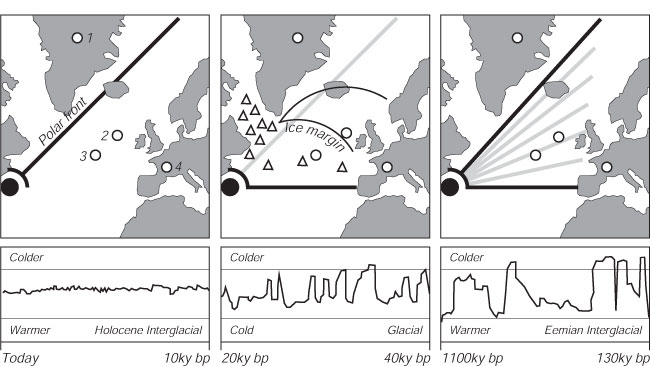
Periodic surges of icebergs during the last ice age appear to have modulated temperatures of the northern hemisphere by lowering the salinity of the far north Atlantic and reducing the meridional overturning circulation. Data from cores through the Greenland ice sheet (1), deep-sea sediments (2,3), and alpine-lake sediments (4) indicate that: Left: During recent times the circulation has been stable, and the polar front which separates warm and cold water masses has allowed warm water to penetrate beyond Norway. Center: During the last ice age, periodic surges of icebergs reduced salinity and reduced the meridional overturning circulation, causing the polar front to move southward and keeping warm water south of Spain. Right: Similar fluctuations during the last interglacial appear to have caused rapid, large changes in climate. The Bottom plot is a rough indication of temperature in the region, but the scales are not the same. From Zahn (1994).
- The observed changes can be explained by the shut-down of the meridional
overturning circulation.
- Melting icebergs lower the salinity of the surface water of the North Atlantic (icebergs are made of frozen fresh water).
- The fresh water never becomes dense enough to sink. Less salty water is less dense that the cold salty water deep in the North Atlantic.
- If the water doesn't sink, warm water is not drawn to the far
north Atlantic.
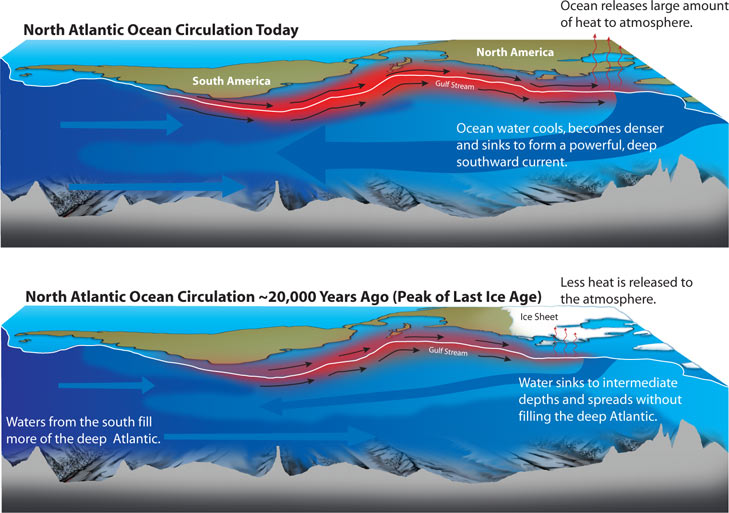
Top: The Atlantic overturning circulation carries a tremendous amount of heat northward, warming the North Atlantic region. It also generates a huge volume of cold, salty water called North Atlantic Deep Water—a great mass of water that flows southward, filling up the deep Atlantic Ocean basin and eventually spreading into the deep Indian and Pacific Oceans.
Bottom: Paleoceanographers have found evidence for very different patterns of ocean circulation in the past. About 20,000 years ago (bottom), waters in the North Atlantic sank only to intermediate depths and spread to a far lesser extent. When that occurred, the climate in the North Atlantic region was generally cold and more variable.
From The Once and Future Circulation of the Ocean. (Illustration by E. Paul Oberlander, Woods Hole Oceanographic Institution)
- The surface circulation of the North Atlantic, including the Gulf Stream, turns eastward, flows toward the Azores, and then southward. The polar front is at the northern edge of this circulation.
- Water north of the polar front freezes. No heat is released from the ocean to the atmosphere to warm Europe, and the northern hemisphere cools.
- The expanded icy areas reflect sunlight, keeping the northern hemisphere cold.
- After many hundreds of years, the water in the North Atlantic becomes salty and begins to sink, pulling warm water northward, and the cold period ends.
- The circulation cannot turn on as soon as the surface water becomes
salty. It must become saltier than normal. Thus once the circulation
shuts off, it remains off for centuries. The delay is due to a
process called hysteresis.
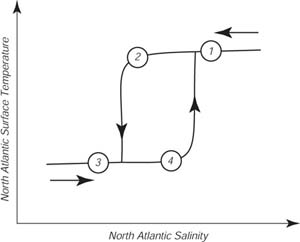
The meridional-overturning circulation is part of a non-linear system. The circulation has two stable states near 2 and 4. The switching of north Atlantic from a warm, salty regime to a cold, fresh regime and back has hysteresis. This means that as surface water in the north Atlantic (1 in the figure) becomes less salty (2 in the figure) it quickly switches to a cold, fresh state (3 in the figure). For the system to switch back to the original state 1, the surface water must become much more salty than at 3 (4 in the figure). This type of behavior is called a hysteresis loop.
- The controversy now is: Will this happen again?
- Will ice melting in Greenland and the Arctic, due to recent global warming, produce enough fresh water to reduce or shut down the meridional circulation?
- Some ocean-atmosphere climate models suggest it is possible,
but not likely.
-Fig-5.gif)
Calculated changes in the Atlantic meridional overturning circulation [strength of the circulation given in Sverdrups (Sv); 1 Sv = 106 m3/s] for a simplified, coupled, ocean-atmosphere, numerical model for 100 model realizations. Radiative forcing is increased from years 1000 to 1140, equivalent to a doubling of CO2, and then held constant. The warming pushes the model closer to the bifurcation point, and transitions usually occur when the overturning is weakened. Two individual realizations are highlighted by the black lines, one in which the THC remains strong but highly variable, and one in which the THC undergoes a rapid transition much later than, and completely unrelated in time to, the forcing. Transitions occur preferentially following a notable reduction of the meridional overturning circulation.
From Alley et al. (2003).
If the circulation shuts down, climate will change. The northern hemisphere is likely to get much colder, but not as fast as in the movie Day After Tomorrow.
Abrupt climate change is due to positive (self-reinforcing) feedbacks that push the climate system into a new, stable state. Other processes inhibit change and stabilize climate, they are negative (self-limiting) feedbacks. Thus, knowledge of feedback is important for understanding abrupt climate change.
Over the past 10,000 years, earth's climate has been remarkably constant. This requires negative feedbacks that stabilize climate. Over other time periods, external forcing such as the amount of sunlight reaching high northern latitudes, pushes the climate system out of equilibrium to the point where positive feedbacks dominate. The positive feedbacks quickly change climate until negative feedbacks again dominate, and the climate system settles into a new, but different state. The forcing that pushes the climaye system out of equilibrium can be external, such as changes in insolation or volcanic eruptions, or internal, such as natural changes within the climate system. El Niño is an example of change due to internal forcing.
Animation of feedback leading to abrupt change.
From NOAA website Defining Abrupt Climate Change.
Here is an animation of two possible states of a system. Initially, external forcing shown by red arrows is too weak to force the ball (which represents the climate system) out of the original state. The ball stays in the valley on the left because negative feedback due to gravity forces the ball back to the bottom of the valley. Eventually, the external forcing is great enough to force the ball to the pass between the two valleys. At the pass, the ball could be stable. But if it moves slightly to the right or the left, positive feedback takes over and rapidly pushes the ball back to the original valley, or rapidly into the new, higher valley on the right. In this example, the force of gravity causing the ball to move is proportional to the slope of the ground (green surface). In the valleys and at the pass, the slope is zero (level ground) and gravity does not move the ball. On sloping ground, the gravity causes the ball to move downhill.
Please remember: positive feedback leads to instability and rapid change. Negative feedback leads to stability and little change.
Feedback:
- Feedback must increase or decrease the rate of change the original variable. If global surface temperature is the original variable, feedback must either amplify or reduce change in global surface temperature.
- If the process leading back to the original variable does not change the original variable, the process is a cycle, such as the carbon cycle. It is not a feedback. In a very simple carbon cycle, phytoplankton grow, absorbing carbon dioxide from the ocean. The phytoplankton then die, decay, and release carbon dioxide back to the ocean. This is a cycle because it does not change the concentration of carbon dioxide in the ocean.
- Positive feedback cannot continue indefinitely. It eventually pushes the system into a new state dominated by negative feedback which reduces the rate of change.
Examples of feedback loops include:
- Positive Feedback (self-reinforcing or amplifiers): More water vapor in the atmosphere increases the greenhouse effect, which warms the ocean, which leads to more evaporation, which leads to more water vapor in the atmosphere. This is a positive feedback. The original variable is water vapor, and the loop increases the rate at which water vapor in the atmosphere changes. It increases faster and faster.
- Negative Feedback (self-limiting or source of persistence): More water vapor in the atmosphere leads to more clouds. Clouds reflect incoming solar radiation (energy), leading to cooling of earth's surface, which reduces evaporation. This is a negative feedback. Again, water vapor is the original variable, but this loop reduces the change in the variable, leading to stability (persistence).
- Here is an animation of two possible states of a system.
Much work is now being done to try to understand which feedbacks dominate the climate system.
An example of a system that has two stable states (top), with negative and positive feedback.
Small displacements of the system from stable state 1 (middle) have negative feedback pushing the system back to state 1.
Large displacements (bottom) have positive feedback pushing the system to state 2.
From The Argentine Foundation for Scientific Ecology.
To learn more about feedback, read this tutorial and these examples of feedback loops in the climate system.
Other Sources of Abrupt Change
The climate system has many feedback loops, including many that are positive (causing amplified change). The climate system is non-linear. Such systems can have abrupt changes when forcing becomes sufficiently strong. For the earth's climate system, the forcing is coming from changes CO2 in the atmosphere. If enough CO2 is put into the air, the system may change in ways we cannot anticipate. The changes in the meridional overturning circulation is one example of abrupt change. But others are possible. Many smaller changes have already been observed. They provide warning that other, larger changes are possible. Do we want to wait for the "violent response"?
Additional Reading
For more on changes in the north Atlantic, read the Great Climate Flip-Flop, originally written for the Atlantic Monthly, by William H. Calvin which describes what we know about the role of the ocean in the last ice age, and implications for the future.
For more on abrupt climate change, read Abrupt Climate Change, a 2003 article in Science by a team of oceanographers and climatologists. Other, more scientific, articles are available in the Proceedings of the National Academy of Science Volume 97, Issue 4.
[If you are a Texas A&M University student, and if you have difficulty downloading the paper, you will need to go througha university library that has a licence to read Science articles.
References
Alley, R. B., J. Marotzke, et al. (2003). "Abrupt climate change." Science 299 (5615): 2005--2010.
Brauer, A., G. H. Haug, et al. (2008). An abrupt wind shift in
western Europe at the onset of the Younger Dryas cold period. Nature
Geoscience 1 (8): 520–523.
Steffensen, J. P., K. K. Andersen, et al. (2008). High-Resolution
Greenland Ice Core Data Show Abrupt Climate Change Happens in Few Years.
Science 321 (5889): 680–684.
The last two abrupt warmings at the onset of our present warm interglacial period,
interrupted by the Younger Dryas cooling event, were investigated at high temporal
resolution from the North Greenland Ice Core Project ice core. The deuterium
excess, a proxy of Greenland precipitation moisture source, switched mode within
1 to 3 years over these transitions and initiated a more gradual change (over
50 years) of the Greenland air temperature, as recorded by stable water isotopes.
The onsets of both abrupt Greenland warmings were slightly preceded by decreasing
Greenland dust deposition, reflecting the wetting of Asian deserts. A northern
shift of the Intertropical Convergence Zone could be the trigger of these abrupt
shifts of Northern Hemisphere atmospheric circulation, resulting in changes of
2 to 4 kelvin in Greenland moisture source temperature from one year to the next.
Revised on: 29 May, 2017


